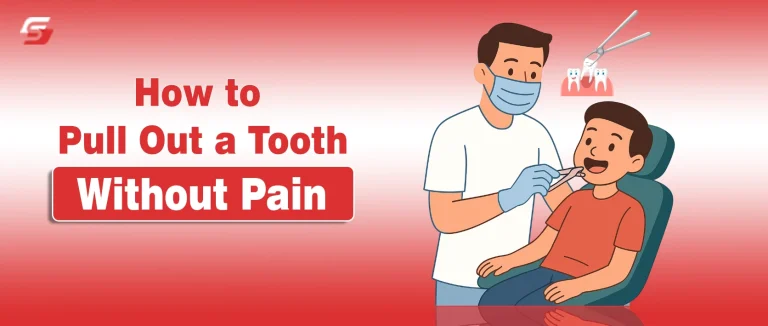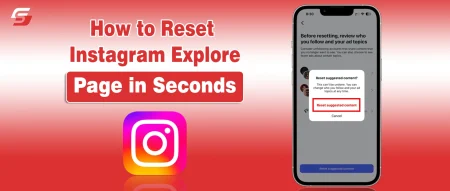Most of us grew up believing that pulling out a loose tooth was as simple as giving it a quick tug, but anyone who’s tried knows it’s rarely that easy. Sometimes the tooth moves freely but refuses to come out, or a small pull turns into an unexpected sting that makes us rethink the whole idea.
If you’ve ever stood in front of the mirror wondering whether to twist, wiggle, or just wait, you’re not alone. A loose tooth is a natural part of growing up or dental change, but removing it safely without pain takes more than guesswork.
In this guide, we’ll walk you through gentle, safe methods to pull out a loose tooth at home. You’ll learn how to keep your gums clean, control bleeding, and prevent infection, all while keeping comfort and safety first.
When It’s Safe (and Not Safe) to Pull Out a Loose Tooth
Knowing when it’s safe to pull out a loose tooth is important to avoid unnecessary pain, infection, or gum damage. A loose tooth may come from natural causes like baby tooth shedding or from injury or disease.
The right approach depends on identifying the tooth type (baby or permanent), the stage of looseness, and the presence of pain or swelling. Pulling a tooth too early can expose the nerve or damage gum tissue, while waiting too long can lead to discomfort or infection.
How Do You Know When a Loose Tooth Is Ready to Come Out?
A tooth is ready to come out when its root has naturally dissolved and it moves freely without pain. This usually happens with baby teeth as part of the normal development cycle.
Signs a tooth is ready to come out:
- The tooth moves easily in all directions with minimal pressure.
- There is no pain, swelling, or bleeding around the gum.
- The new tooth (adult tooth) is visible underneath or behind the loose one.
If the tooth causes pain when touched, feels firmly anchored, or shows redness in the surrounding gum, it is not ready to be removed. Forcing it can cause bleeding or infection.
Signs Your Tooth Is Ready vs. When Not to Pull at Home
The readiness of a loose tooth depends on how naturally it detaches from the gum. A safe pull requires that the tooth is nearly detached, while unsafe pulling involves forcing a semi-loose or infected tooth.
| Ready to Pull | Not Safe to Pull at Home |
| Wiggles freely without pain | Causes pain or bleeding when touched |
| No redness or swelling | Gum looks inflamed or discolored |
| Tooth has separated from gum edge | Still feels firmly connected |
| Adult tooth visible beneath | No replacement tooth seen yet |
If your tooth falls under the “Not Safe” side, consult a dentist before trying to remove it.
Difference Between Baby Teeth and Permanent Teeth
The type of tooth determines whether you should pull it at home.
- Baby teeth naturally loosen as their roots dissolve to make room for adult teeth. They can usually be pulled safely when loose enough.
- Permanent teeth should never be pulled at home. Looseness in adult teeth often indicates gum disease, trauma, or infection, and requires professional dental evaluation.
Pulling a permanent tooth without medical guidance can cause nerve damage, bone exposure, or severe infection.
Should You Pull or Wait for It to Fall Out Naturally?
The best option depends on the looseness level and the comfort of the individual, especially children.
- If the tooth moves freely and causes no discomfort, gentle wiggling with clean hands or gauze helps it come out naturally.
- If it causes pain or resistance, waiting allows the root to dissolve completely and reduces bleeding risk.
- Encourage natural loss during brushing or chewing instead of applying direct force.
In most cases, patience ensures safer tooth removal and avoids gum injury.
When to Seek a Dentist’s Advice Before Pulling
You should seek dental consultation before pulling if:
- The tooth loosening follows an injury or fall.
- The gum area shows swelling, pus, or severe redness.
- The tooth belongs to an adult or seems loose due to decay.
- The child complains of sharp pain or bleeding that doesn’t stop easily.
A dentist can determine if the tooth needs professional extraction, cleaning, or monitoring. In some cases, the dentist may use local anesthetic or sterile tools to ensure a pain-free and hygienic removal. If your loose tooth feels painful or cracked, it may need more care than a simple pull, explore our guide on how to fix a cracked tooth naturally to understand safe home remedies and when to see a dentist.
Pain-Free and Gentle Tooth Removal Methods
A pain-free tooth removal depends on using clean tools, gentle techniques, and the right timing. When a loose tooth is already detached from most of its root, removing it can be nearly painless if handled carefully.
The goal is to avoid damage to the surrounding gum tissue and prevent unnecessary bleeding. Using slow movements, steady pressure, and mild numbing methods like cold compresses helps reduce discomfort. Proper hygiene before and after removal also ensures a safe and infection-free process.
Step-by-Step Painless Tooth Removal Process
A step-by-step approach ensures the tooth comes out cleanly without pain or infection. Each step focuses on minimizing gum irritation and maintaining oral hygiene.
Safe tooth removal process:
- Wash hands thoroughly to prevent bacteria transfer.
- Rinse the mouth with warm salt water to clean the area.
- Check the looseness the tooth should move easily in all directions.
- Grip the tooth gently using sterile gauze or tissue for a firm hold.
- Apply slow, steady pressure while twisting slightly to detach remaining fibers.
- Use gauze to stop bleeding and keep the area clean after removal.
If any step causes sharp pain or resistance, stop immediately and wait for further loosening or consult a dentist.
Gentle Wiggling and Twisting Techniques
The wiggling method helps the tooth detach naturally from its remaining root fibers. It should always be performed gently and consistently rather than forcefully.
- Gentle wiggling: Use clean fingers or gauze to move the tooth side-to-side and back-and-forth several times a day. This helps loosen the connecting tissue gradually.
- Twisting motion: When the tooth becomes very loose, a small circular or twisting motion helps release it smoothly without tearing the gum.
- Avoid pulling straight unless the tooth feels completely detached, pulling too early causes pain and bleeding.
These gradual movements reduce pressure on nerves and ensure a painless release when the tooth is ready.
Using Floss Safely to Extract a Loose Tooth
Dental floss can assist with painless tooth extraction when used correctly. The floss must be clean, unwaxed, and placed securely at the base of the loose tooth.
Safe floss technique:
- Tie the floss around the base of the tooth with a gentle knot.
- Pull the ends upward and slightly forward, not straight out.
- Apply slow, steady tension until the tooth detaches.
- Place sterile gauze immediately after removal to manage minor bleeding.
Avoid using floss on teeth that are not completely loose or those surrounded by swollen gums. Forcing it can tear gum tissue or cause pain.
Numbing Options | Cold Compress or Topical Anesthetic
Numbing methods reduce discomfort and calm gum sensitivity during removal. The two most effective home options are cold compresses and topical anesthetics.
- Cold compress: Applying an ice pack wrapped in cloth to the cheek for 5–10 minutes numbs the area naturally and reduces swelling.
- Topical anesthetic gel: Over-the-counter gels containing benzocaine can temporarily numb the gum surface. Always follow product instructions carefully.
- Cold rinse: Swishing cold water before removal also provides mild numbing and helps with bleeding control.
These methods lower nerve sensitivity, making tooth extraction more comfortable and pain-free.
Should You Pull a Tooth Quickly or Slowly for Less Pain?
The speed of tooth pulling affects pain levels and tissue damage. A slow and controlled pull is safer and less painful than a quick, forceful motion.
| Method | Effect on Pain | Safety |
| Quick Pull | May cause sharp pain and bleeding | Risky if tooth not fully loose |
| Slow, Steady Pull | Reduces nerve shock and tearing | Recommended and safe |
A slow motion allows gum fibers to release naturally and helps prevent bleeding or nerve irritation. Only attempt removal when the tooth feels ready and moves easily without resistance.
Tooth Extraction Aftercare and Infection Prevention
Tooth extraction aftercare ensures proper gum healing and prevents infection. Once a loose tooth is removed, the gum tissue becomes sensitive and vulnerable to bacteria. Effective oral hygiene, controlled bleeding, and gentle rinsing support natural recovery. To keep your mouth free from bacteria after tooth removal, make sure your dental gear stays clean, you can also read our guide on how to clean a night guard properly for better oral hygiene practices.
Avoiding harsh brushing, hot foods, and contaminated contact keeps the area clean and pain-free. A structured aftercare routine also helps the blood clot to form properly, which protects the exposed socket during healing.
What Should I Do After Pulling Out a Loose Tooth?
Immediate care after tooth removal focuses on stopping bleeding, protecting the gum, and preventing infection.
- Bite gently on a sterile gauze pad for 10–15 minutes to help form a clot.
- Keep the mouth closed and avoid talking or spitting during the first hour.
- Replace the gauze if it becomes soaked with blood, but avoid disturbing the clot.
- Rest and keep your head slightly elevated to control blood flow.
These actions help the gum tissue stabilize and begin its natural healing process.
How to Stop Bleeding Safely
Bleeding control is essential after a tooth extraction. Normal bleeding should stop within 30–60 minutes if managed properly.
- Use clean, folded sterile gauze and apply gentle pressure by biting down.
- If gauze is unavailable, a damp tea bag can help due to its tannins that aid clotting.
- Avoid rinsing, sucking through a straw, or touching the site for several hours.
- If bleeding continues beyond two hours, contact a dentist.
Proper clot formation seals the gum opening and prevents dry socket or infection.
Cleaning the Gum and Using Saltwater Rinse
Cleaning the gum after a tooth extraction should start 24 hours after removal to avoid disturbing the clot.
- Mix ½ teaspoon of salt in a glass of warm water.
- Rinse gently, allowing the solution to move naturally around the mouth.
- Repeat two to three times daily, especially after meals.
The saltwater rinse reduces bacteria, soothes inflamed tissue, and promotes faster gum recovery. Avoid mouthwashes with alcohol, as they can irritate the exposed area.
How Long the Gum Takes to Heal
Gum healing time after a loose tooth extraction depends on the individual’s oral health and the tooth type.
| Tooth Type | Average Healing Time | Healing Characteristics |
| Baby Tooth | 3–7 days | Gums close quickly; minimal swelling |
| Permanent Tooth | 1–2 weeks | Longer healing; clot protection needed |
During this period, avoid touching the site and maintain gentle cleaning habits. Full tissue recovery occurs once the gum closes and sensitivity disappears.
Avoiding Infection and Keeping the Area Clean
Infection prevention is crucial to safe healing. Bacteria can enter the open socket if hygiene is neglected.
- Wash hands before touching the mouth.
- Continue daily brushing and flossing, avoiding the extraction site directly.
- Do not use unclean utensils or touch the gum with fingers.
- Use a soft-bristled toothbrush and gentle circular motions.
- If swelling, pus, or fever develops, seek dental care immediately.
A clean environment and consistent care reduce the risk of infection and promote healthy gum regeneration.
When It’s Safe to Eat, Brush, or Rinse Again After Tooth Removal
Resuming normal oral activities should happen gradually after extraction.
- Eating: Wait at least one hour before consuming soft foods; avoid chewing near the extraction site for 24 hours.
- Brushing: Continue brushing other teeth the same day but skip the extraction area until the next day.
- Rinsing: Begin gentle saltwater rinses after 24 hours to aid cleaning and comfort.
Avoid alcohol-based mouthwash, spicy food, or vigorous swishing during the first two days to prevent clot displacement.
What Foods to Eat and Avoid After Tooth Removal
Diet after tooth removal supports healing and reduces gum irritation.
Recommended foods:
- Soft items like yogurt, mashed potatoes, smoothies, and applesauce
- Lukewarm soups and scrambled eggs for easy chewing
- Cold treats like ice cream or soft fruit to soothe inflammation
Foods to avoid:
- Hard or crunchy items (chips, nuts, crusty bread)
- Hot or spicy meals that can irritate the gum
- Sticky or chewy foods like candy or caramel that may pull the clot
A soft and balanced diet helps maintain nutrition while allowing the gum tissue to heal naturally.
Final Thoughts | The Right Way to Remove a Loose Tooth Without Pain
Pulling out a loose tooth doesn’t have to be a moment of hesitation or fear, it can be simple and safe when done with care. Our goal is to help you approach this small but sensitive task with confidence, using gentle, proven methods that protect your gums and minimize discomfort.
We always recommend taking things slow, keeping your hands and tools clean, and letting the tooth loosen naturally when possible. A calm, careful approach prevents bleeding and helps the area heal faster afterward.
At StuffABlog, we believe small steps in hygiene and patience lead to big results in comfort and safety. So before giving that final pull, pause, follow our pain-free tips, and let your smile stay healthy and stress-free.
Frequently Asked Questions
Baby teeth loosen when permanent teeth begin pushing upward, dissolving the roots of the primary tooth naturally.
A baby tooth will not tighten again, but a slightly loose adult tooth may stabilize if the gum and bone heal properly.
Swallowing a small tooth is usually harmless; it passes naturally through the digestive system without medical concern.
Mild discomfort is normal as the gum tissue stretches and detaches, but sharp pain may indicate infection or irritation.
If a tooth breaks midway, rinse the mouth, avoid touching the area, and contact a dentist to remove the remaining part safely.











